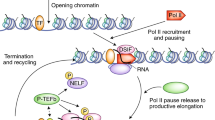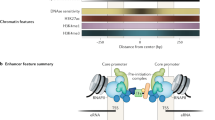Abstract
The regulation of eukaryotic gene transcription poses major challenges in terms of the innumerable protein factors required to ensure tissue or cell-type specificity. While this specificity is sought to be explained by the interaction of cis-acting DNA elements and thetrans-acting protein factor(s), considerable amount of degeneracy has been observed in this interaction. Immunoglobulin heavy chain gene expression in B cells and liver-specific gene expression are discussed as examples of this complexity in this article. Heterodimerization and post-translational modification of transcription factors and the organization of composite promoter elements are strategies by which diverse sets of genes can be regulated in a specific manner using a finite number of protein factors
Similar content being viewed by others
References
Dwarki V J, Francis V SN K, Bhat G J and Padmanaban G.1987 Regulation of cytochrome P-450 gene transcription, messenger RNA and apoprotein levels by heme;J. Biol. Chem. 262 16958–16962
Gerster T, Matthias P, Thali M, Jiricny J and Schafner W 1987 Cell type specificity elements of the immunoglobulin heavy chain gene enhancer;EMBO J. 6 1323–1330
Green M R 1992 Transcriptional transgressions;Nature (London) 357 364–365
He J-S and Fulco A J 1991 A barbiturate-regulated protein binding to a common sequence in the cytochrome P-450 genes of rodents and bacteria;J. Biol. Chem. 266 7864–7869
Johnson P F and McKnight S L 1989 Eukaryotic transcriptional regulatory proteins;Annu. Rev. Biochem. 58 799–839
Lai E and Darnell J E Jr 1991 Transcriptional control in hepatocytes;Trends Biochem. Sci. 16 427–430
Lamb P and McKnight S L 1991 Diversity and specificity in transcriptional regulation: the benefits of heterotypic dimerization;Trends Biochem. Sci. 16 417–422
Miner J N and Yamamoto K 1991 Regulatory crosstalk at composite response elements;Trends Biochem. Sci. 16 423–426
Parvin J D, Marc Timmers H Th and Sharp P A 1992 Promoter specificity of basal transcription factors; Cell 68 1135–1144
Ptashne M 1988 How eukaryotic transcriptional activators work;Nature 335 683–689
Poornima U, Venkateswara Rao M, Venkateswar V, Rangarajan P N and Padmanaban G 1992 Identification and functional characterization of a cis-acting positive DNA element regulating CYP2B1/B2 gene transcription in rat liver;Nucleic Acids Res. 20 557–562
Rangarajan P N, Ravishankar H and Padmanaban G 1987 Isolation of a cytochrome P-450e gene variant and characterization of its 5’-flanking sequences;Biochem. Biophys. Res. Commun. 114 258–263
Rangarajan P N and Padmanaban G 1989 Regulation of cytochrome P-450 b/e gene expression by a heme-and phenobarbitone-modulated transcription factor;Proc. Natl. Acad. Sci. USA 86 3963–3967
Roeder R G 1991 The complexities of eukaryotic transcription initiation: regulation of pre-initiation complex assembly;Trends Biochem. Sci. 16 402–408
Sawadogo M and Sentenac A C 1990 Polymerase B (II) and general transcription factors;Annu. Rev. Biochem. 59 711–754
Schreiber E, Miller M M, Schaffner W and Matthias PC 1989 Octamer transcription factors mediate B-cell specific expression immunoglobulin heavy chain genes; inTissue specific gene expression (ed.) R Renkawitz (Weinheim: VCH Verlagsgesellschaft) pp 33–51
Spencer C A, Lestrange R C, Novak V, Hayward W and Groudine M C 1990 The block to transcription elongation is promoter dependent in normal and Burkitts Lymphoma c-myc alleles;Genes Dev. 4 75–88
Wasylyk B 1988 Enhancers and transcription factors in the control of gene expression;Biochim. Biophp Acta 951 17–035
Wirth T, Staudt L and Baltimore DC 1987 An octamer oligonucleotide upstream of a TATA motif is sufficient for lymphoid-specific promoter activity;Nature (London)) 329 174–178
Author information
Authors and Affiliations
Additional information
Based on the lecture given at the Symposium on “Regulation of Gene Expression” held in Bangalore on January 20–21, 1992.
Rights and permissions
About this article
Cite this article
Padmanaban, G. Specificity in the regulation of eukaryotic gene transcription. J Biosci 18, 27–36 (1993). https://doi.org/10.1007/BF02703035
Received:
Revised:
Issue Date:
DOI: https://doi.org/10.1007/BF02703035




